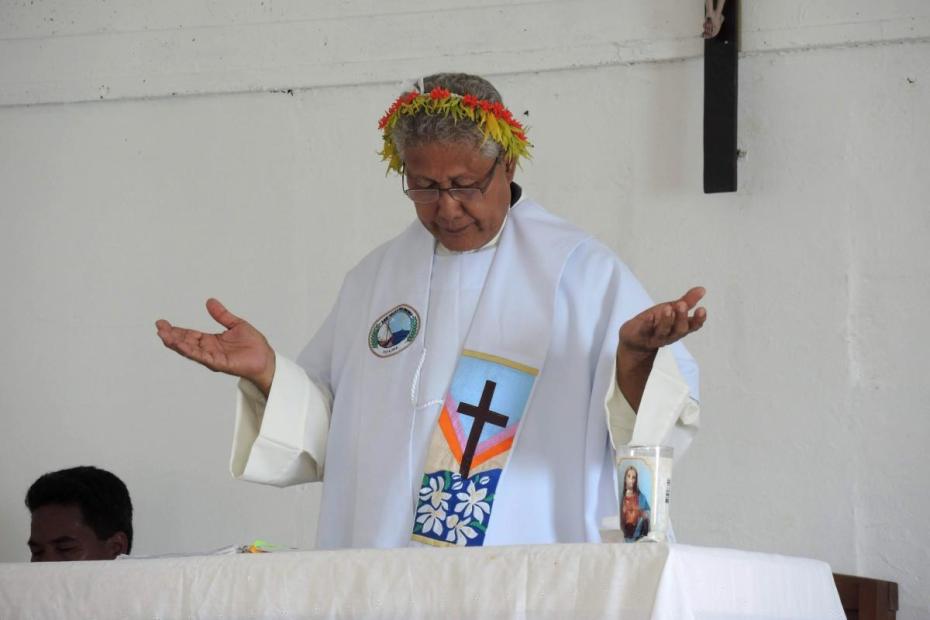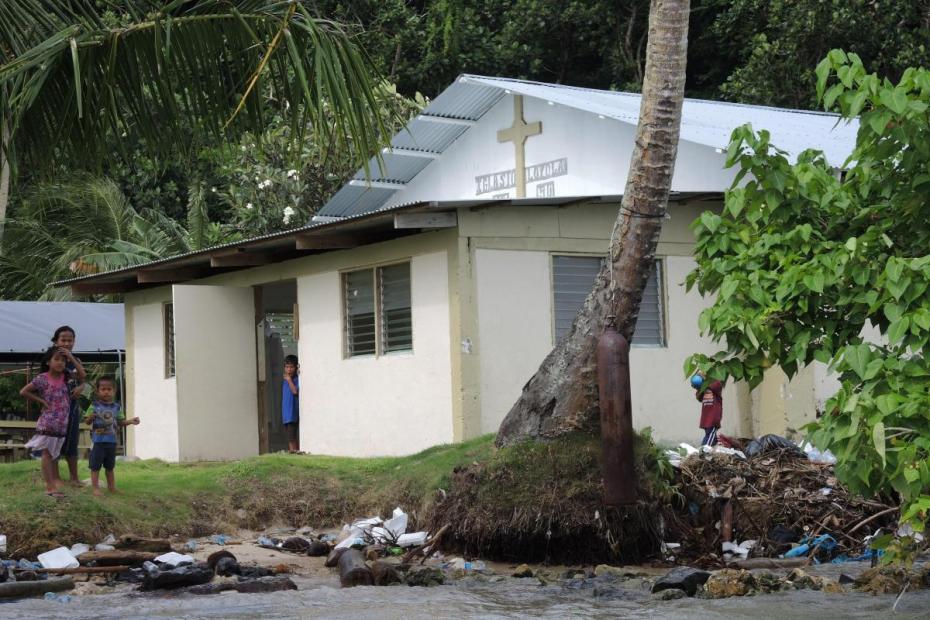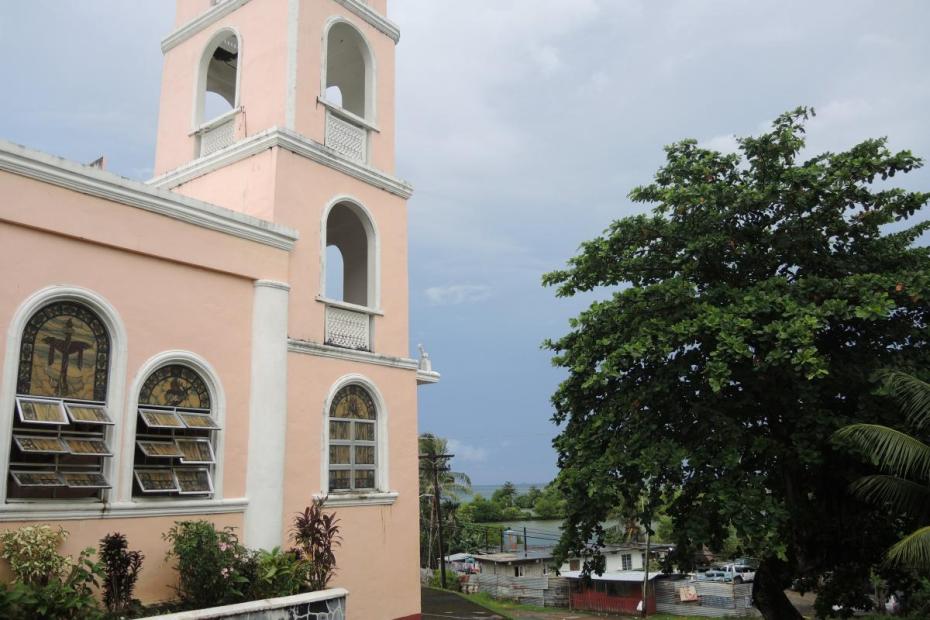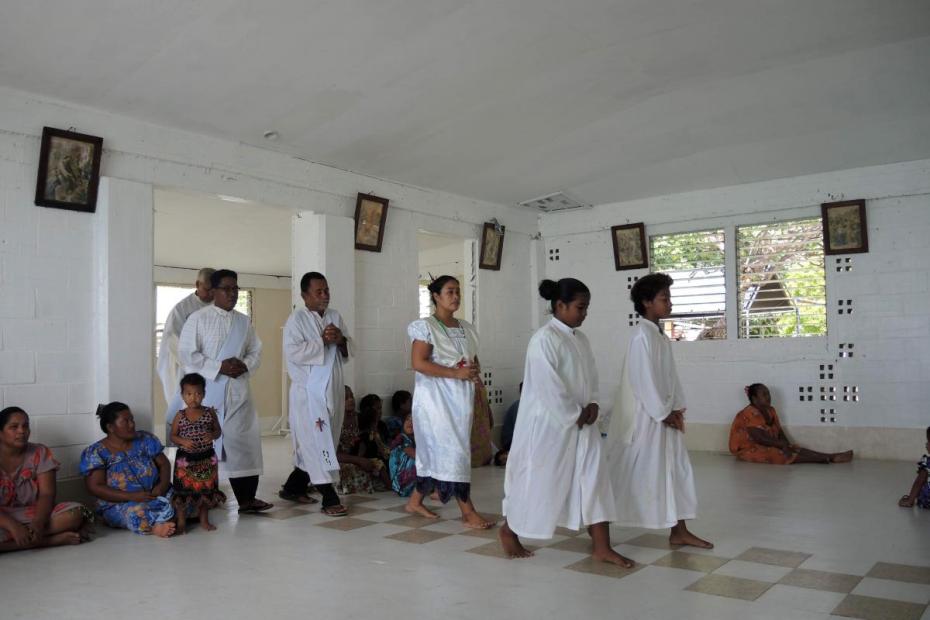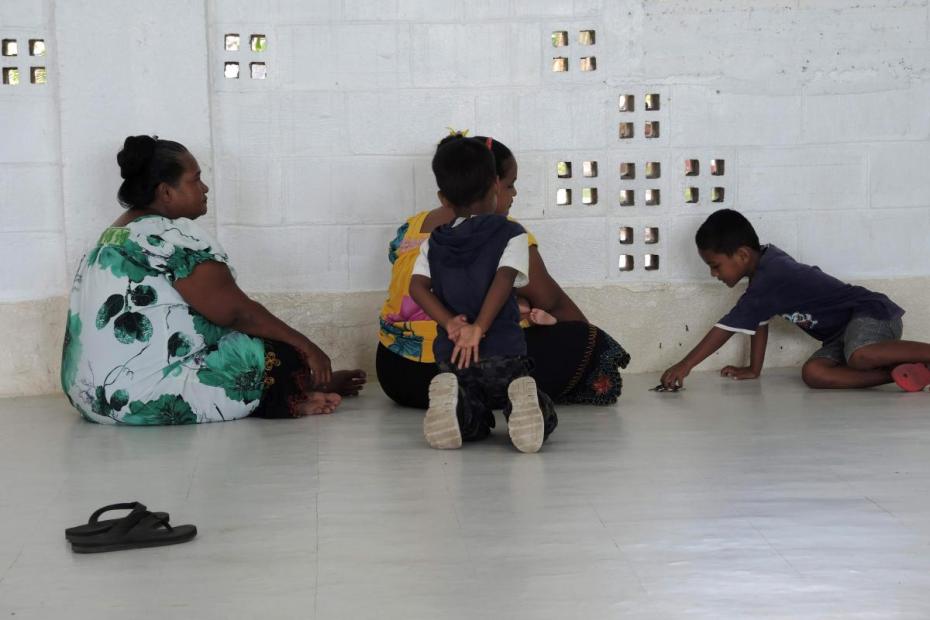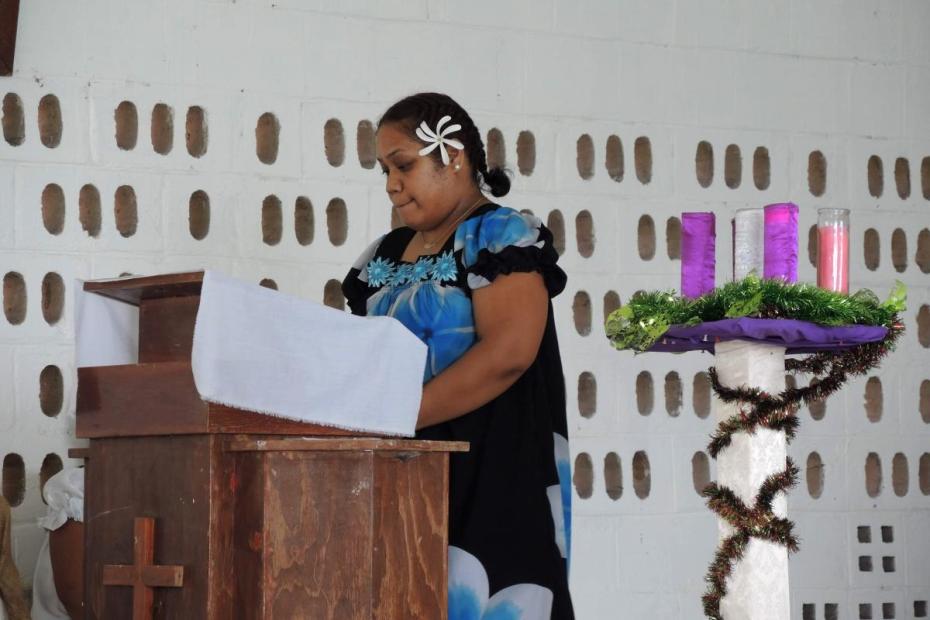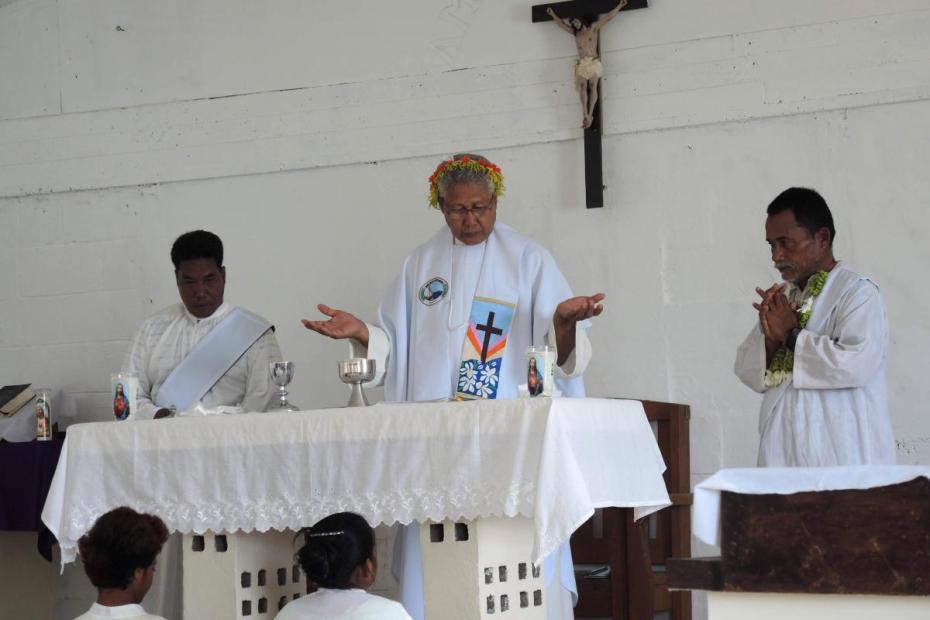Devotion manifests itself differently in particular cultural contexts around the world. In Chuukese society, devotion is shown in a way that might be puzzling to outsiders who do not know how to read the behaviors. A visitor from another culture who expects to see expressive, outwardly emotional forms of worship would be perplexed by the generally very sedate style of Chuukese worship. There are exceptions to this, such as when Chuukese sing at Mass, but even on those occasions, while people do express joy or sadness in their singing, they can seem quite restrained compared to some other cultures’ style of sung prayer.
Respect, the paramount value in Micronesian society, is communicated by deference: by speaking quietly and often lowering one’s eyes; by trying not to “stand above” another; or even trying not to stand out from the crowd. Calmness and understatement is the norm in ordinary encounters. To draw attention to oneself in a theatrical way is regarded as a form of arrogance that puts oneself, not the community, first, and is disrespectful. Even a chief is expected to fulfill his duties modestly. “This deference is part of a larger system of respect and ranking such that everyone—male and female—defers to someone else.”1
So it is at worship. Acts that would make any one person look more pious than others or would display individual emotion for special effect, are looked down upon. The lector’s style as a reader, the priest’s demeanor as a celebrant or homilist, the singer’s style in the choir, the congregant’s style at prayer, all needs to situate her or him as a member of the community, not above it.
Song plays a special role in Chuukese worship. Chuukese Catholics spend time practicing songs and are adept at singing in choral form, whether a capella or with accompaniment by a ukelele, the small stringed instrument from Hawaii. Again, that style entails contributing to the whole, not standing out musically above others.
Dance has a place in Chuukese culture, but not in church worship.
Respect and the physical space of liturgy
In the Chuukese Outer Islands, as in the Chuuk Lagoon island of Fono, Chuukese traditionally sit (and usually sleep) on the floor in their homes, a position that makes particular sense on hot, humid islands. Likewise, worshippers in many Catholic churches usually sit on the floor as well. To be sitting on the floor is not a dishonor or sign of disrespect. It occurs not only for practical purposes, but to show deference and respect to others. The celebrants stand, as the liturgy requires, and sit on chairs, an accommodation worked out for church situations in light of their status. Some older men and women occasionally sit on chairs too. Traditional island culture separates men and women in many ordinary interactions. Separation is observed to some degree in the church in Fono, but there are women serving as lectors and altar girls. Women sat on the left and/or in the back, men on the front right, though there were some exceptions. The women who led the singing sat closer to the front, at about the middle of the church. Traditionally, people are expected to defer and not put themselves forward, “above” others, and this showed in the seating. Notably, the two big churches on Weno, the more developed island and capital town, have wooden pews.
Women all dress in colorful muumuus for church, a style that apparently owes its origin in part to missionaries, but that has come to signal Chuukese cultural identity, above all respect and modesty, key cultural values. The dresses are floor length, since it is unacceptable for women to show their thighs.
Those gendered conventions of deference also impact who is inside the church and who is more likely to remain outside. As is true in many parts of the world, women are commonly said to be more religious than men. At Rosaries and funeral novenas women tend to sit inside, while the men sit or stand outside, and women vocalize more of the prayer and song. But the gendered arrangements of space are more complicated than that. By tradition on islands like Fono, respectful behavior requires that women never stand above their “brothers” (a group that includes their own male siblings, cousins and uncles, but not husbands or fathers). Whenever their brothers are sitting on the floor, women crawl on their knees around the brothers, so as not to rise above them.2 That behavior can be seen in the video here from a reconciliation service at St. Ignatius Church on Fono island.3 Whereas outsiders who saw it in church might misperceive such movement as a sign of gendered Christian piety, the posture actually fulfills the highly standardized family norms of traditional Chuukese culture.4
These norms also affect where and how men participate. At the Advent penance service, when women outnumbered men three to one inside the church, it was remarkable to see the number of men who walked in for individual confessions, then disappeared outside for the rest of the service. As a sign of respect for women, to save them from needing to crawl, “brothers” stand in the vestibule, or outside. If one counts the men standing outside, the gender ratio for participation was much more balanced than it appeared from inside the church.
The Church has insisted on one adaptation, visible in the video from a Mass in the same Fono church. At communion, everyone comes forth walking and standing fully upright, to reinforce that all are equal in the eyes of God. Interviewees noted that Communion arrangements had evolved in other ways. Francis Hezel, S.J. confirms, “On some islands it was [once] regarded as scandalous for a brother and sister to share food or even drink out of the same cup.”5 These rules changed for Communion, and have since also changed for other meals. Still, Chuukese women interviewed said that women Eucharistic ministers still pose a problem culturally. The Church has adapted this in much of the Chuuk Lagoon, but less so, women said, in the Outer Islands. In her study on the Chuukese Outer Island of Pulap (Pollap), Juliana Flinn found that there was great local uncertainty about how to deal with having women serve as lectors, because they would be standing when their brothers were sitting. “The most common custom discussed as posing potential conflict with religion is, in fact, this particular sign of respect.”6 Women who were interviewed for this project heard that there was talk of women deacons on the global Church, but as one summarized, “It’s not for us.”
One priest related a story of a poorly informed visiting missionary, who on one of his first Sundays there was asked to celebrate Mass on one of the islands on Mother’s Day. At the end, he asked the mothers to stand up for a blessing. All the men stood up. Confused, he told them to sit, saying that he meant mothers. But then the mothers would not stand. He tried again and the men stood up, then the women. He left the occasion totally baffled, only later to have it explained that the men had stood up as a courtesy for the women, so that those who had brothers in the church could stand.
To be sure, not all the deference customs that pose challenges to worship entail sisters being deferential to brothers. Codes of deference by younger brothers to older ones are also important. Flinn reported on Pulap, “On Ash Wednesday… a few men who are ‘older brothers’ to lay leaders apply the ashes to themselves, as according to tradition, no one—not even a church leader—should touch the forehead of a senior sibling.”7
Churches in Weno, which is more westernized in a variety of ways, have benches. The style of worship is otherwise similarly low-key, even as the traditional arrangements no longer predominate in a church with pews.
Other aspects
The visual style of churches is not especially adapted or inculturated to any local, pre-colonial style, though churches are designed to suit the climate and to better withstand typhoons than traditional ones could. Almost all of the islands’ buildings and design are modern or at least Western. “Modernization” under a variety of colonial powers started the process. Devastation in World War II and in subsequent typhoons completed it. The use of flowers and decorations at feasts reflects a contemporary local aesthetic. Statues of Mary and Jesus in the churches look decidedly Western, often in the image of the Sacred Heart and Immaculate Conception.
Two forms of inculturation deliberately introduced by the Church, though not always used, include the presentation of lei flowers to the celebrants at the offertory, and, for very special occasions, processions that carry the Gospel and the gifts in ritualized form on platforms borne on the shoulders of lay people.
Chuukese who were bilingual all indicated in interviews that they preferred to pray in Chuukese, and that the Chuukese prayers just worked better. “Your name is honored” works much better, one said, than “hallowed be thy name.”
- 1Juliana Flinn, Mary, the Devil, and Taro: Catholicism and Women's Work in a Micronesian Society (Honolulu: University of Hawai'i Press, 2010), 95.
- 2Some kinds of gendered distinctions are breaking down in Chuuk, or at least being transformed, but on some islands norms like this remain powerful. When a group of a dozen male and female high school students from various islands at Xavier High School, Micronesia’s most prominent high school, were asked if they expected these rules about relations between brothers to disappear in their lifetimes, all were sure they would not, and saw such changes something they would not want to see, from a perspective of cultural preservation.
- 3Flinn describes a similar arrangement on Polap: Mary, the Devil, and Taro, 51.
- 4Flinn notes similar spatial arrangements in the church at Pollap, a far outer island. Flinn, Mary, the Devil, and Taro, 118.
- 5Francis X. Hezel, S.J., Making Sense of Micronesia: the Logic of Pacific Island Culture (Honolulu: University of Hawai’i, 2013), 102-103.
- 6Flinn, Mary, the Devil, and Taro, 106.
- 7Flinn, Mary, the Devil, and Taro, 107.
